-
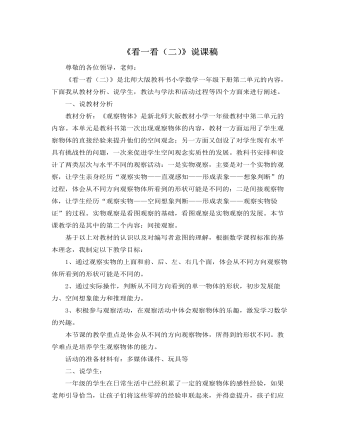
北师大版小学数学一年级下册《看一看(二)》说课稿
这样的设计是因为低年级的学生比较喜欢听故事,充分调到他们的积极性,使之不感觉乏味。最后是回顾小结,总结收获。首先让学生说说本节课有哪些地方需要提醒同学们注意。。然后,教师进行恰当评价。此环节通过师生互动、生生互动,经历一次再学习、再巩固的过程。这节课中,我有浅入深,让学生体会到数学与现实生活的密切联系,让学生能够实实在在的从课堂学习中获取新知,建立数学模型,培养能力,发展思维,从而喜欢数学课,热爱数学学科。整堂课教学设计结构严谨、条理清楚、层层深入。既重视了知识本身的建构,又重视了课堂结构的建构,充分体现了学生从“问题情境—建立数学模型—解释、应用与拓展”的意义建构的学习过程。学习无止境,在今后的教学中,我会更加努力地钻研教材、设计教法,力争使每一节数学课都能达到理想的教学效果。
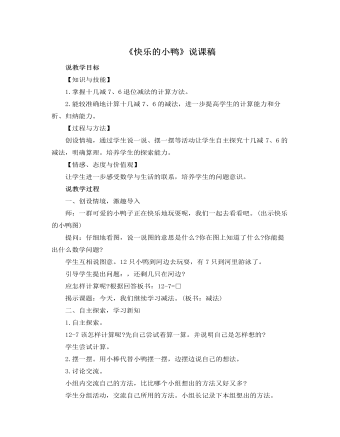
北师大版小学数学一年级下册《快乐的小鸭》说课稿
说教学目标【知识与技能】1.掌握十几减7、6退位减法的计算方法。2.能较准确地计算十几减7、6的减法,进一步提高学生的计算能力和分析、归纳能力。【过程与方法】创设情境,通过学生说一说、摆一摆等活动让学生自主探究十几减7、6的减法,明确算理。培养学生的探索能力。【情感、态度与价值观】让学生进一步感受数学与生活的联系,培养学生的问题意识。说教学过程一、创设情境,激趣导入师:一群可爱的小鸭子正在快乐地玩耍呢,我们一起去看看吧。(出示快乐的小鸭图)提问:仔细地看图,说一说图的意思是什么?你在图上知道了什么?你能提出什么数学问题?学生互相说图意。12只小鸭到河边去玩耍,有7只到河里游泳了。引导学生提出问题:,还剩几只在河边?

新人教版高中英语必修2Unit 5 Music-Discovering Useful Structures教案一
Step1:自主探究。1.(教材P52)Born(bear) in the USA on 2 January 1970, Whitacre began studying music at the University of Nevada in 1988.2.(教材P52) Moved(move) by this music, he said, “It was like seeing color for the first time.”3.(教材P56)I was very afraid and I felt so alone and discouraged(discourage).4.(教材P58)Encouraged(encourage) by this first performance and the positive reaction of the audience, I have continued to play the piano and enjoy it more every day.Step2:语法要点精析。用法1:过去分词作表语1).过去分词可放在连系动词be, get, feel, remain, seem, look, become等之后作表语,表示主语所处的状态Tom was astonished to see a snake moving across the floor.汤姆很惊讶地看到一条蛇正爬过地板。Finally the baby felt tired of playing with those toys.终于婴儿厌倦了玩那些玩具。注意:1).过去分词作表语时与被动语态的区别过去分词作表语时,强调主语所处的状态;而动词的被动语态表示主语是动作的承受者,强调动作。The library is now closed.(状态)图书馆现在关闭了。The cup was broken by my little sister yesterday.(动作)昨天我妹妹把杯子打碎了。2)感觉类及物动词的现在分词与过去分词作表语的区别过去分词作表语多表示人自身的感受或事物自身的状态,常译作“感到……的”;现在分词多表示事物具有的特性,常译作“令人……的”。

新人教版高中英语必修2Unit 5 Music-Discovering Useful Structures教案二
4. When he got absorbed in his world of music, he felt as if he could “see” the beauty of the world around him, like he had in his previous life.P·P as adverbial: _________________________________________________________________.Function: _______________________________________________________________________.Step 5 Solid Complete the passage with the words in brackets in their correct forms.Well known as a successful band, the Impact members show quite a few striking qualities. They never ever give up. When _____________(question) by the media, they are not _____________(discourage) and practise even harder. They are improving themselves by attending several master training class. They are united. _____________(fill with) team spirit, they act as a whole, always aiming for glory. Step 6 Difference and similarity from -ingObserve the following examples.1. He went out, shutting the door behind him.=He went out, ________________________________________________________.2. Not knowing what to do, he went to his parents for help.=__________________________________________, he went to his parents for help.Similarity: _______________________________________________________________________________________________________________________________________________________.Difference : _______________________________________________________________________________________________________________________________________________________.Step Practice1. ________ in a hurry, this article was not so good. 因为写得匆忙, 这篇文章不是很好。2. ________ carefully, he found something he hadn’t known before. 他仔细读书时, 发现了一些从前不知道的东西。3. ________ why he did it, the monitor said it was his duty. 当被问及他为什么要这么做时, 班长说这是他的职责

新人教版高中英语必修2Unit 5 Music-Listening&Speaking&Talking教案
choir memberspeople to run food stands people to sell festival ticketspeople to sell music CDspeople to set up equipmentmusical performersStep 2: Listen to the announcement again and answer the questions. ? 1. What kind of songs will Grace Davis sing at the festival?? 2. Who can try out as a performer?? 3. What can those who think they do not have musical talent do?? 4. How can students volunteer to take part?? Talking about preferences:? Would you prefer doing ..?? What would you prefer to do?? Would you rather do .... or ….?? What would you rather do?? I'd prefer .... to ..? I'd rather have ... than .. Step 3: Speaking ProjectWork in groups. Role-play the conversation or make a new one.? Debbie: Where have you been? You missed the announcement about the music festival.? John: I was at the doctor's office. Music festival?? Frank: Yes, it's going to be next month on the school sports field. John, you can play the piano. How about playing it at the festival?? John: Well, I'd rather play the violin. I can play Liang Zhu.? Frank: Wow! Sounds good. What about you, Debbie? ? Debbie: Actually, I don't have much musical ability. I'd prefer just to help out with the crowds.? Frank: You can sell tickets or work at a food stand.? John: So can I assume that the aim of the festival is to raise money?? Debbie: Yes. All of the money will go to charity.

新人教版高中英语必修2Unit 5 Music-Listening and Speaking教案
This lesson is about music. Students can classify the types of music through the instruments and its sound and can talk about their preferences about music, even join some activities and play a role in them according to their musical talents. On the basis, they are guided to use the languages to express their preferences and some plosive sounds and their rules.1. Classify the music types through the instruments and its sound.2. Listen and understand what the speakers’ preferences are and the reasons; talk about their own preferences and give their own reasons, using these sentences: “What kind of music do you like? And why? “ “Because it makes/gives me energy/peaceful.../touches my heart...”.3. Learn some plosives and the rules.4. Join some activities and play a role in them according to the talents. 1. Listen and understand what the speakers’ preferences are and the reasons;2. talk about their own preferences and give their own reasons, using these sentences: “What kind of music do you like? And why? “ “Because it makes/gives me energy/peaceful.../touches my heart...”.3. Learn some plosives and incomplete plosives and its rules.Step 1 Lead inPoint at the pictures on P50 and ask Q1: What are the people doing in the pictures below?Q2: What kind of music they are?Then play the MP3s one by oneStep 2 ListeningTask 1: A reporter from the school newspaper is interviewing students about music. Listen to the interviews. Draw lines between the words to make complete sentences. Some words will not be used.

新人教版高中英语必修2Unit 5 Music-Reading and Thinking教案二
1. Get basic information about Eric; read deeply to understand the history and development of the virtual choir.2. Understand what the function of the virtual choir is and how to make a virtual choir.3. Understand the meaning of some languages in the context of the text through question guidance, such as “Many people do not have close friends or contacts who have the same interest in music.” and so on.Step 1 Leading-in1. Answer the following questions.Q1:Do you know the Apps like Tik Tok and Quick Hand?Q2: Do you want to make a Tik Tok video or a Quick Hand video?2. Play a Tik Tok video Step 2: Understanding the title Q1:What does the title mean ?Q2: Is the article a narration or exposition? Why? Q3: Can you change the title ? If you can, what is the title?Step 3: Scanning the whole text and getting the basic information1. Answer the following questions.Q1:Who came up with the idea for a virtual choir?Q2: Where did Eric studied the musical composition?Q3: What is his song?2. Find the main idea of each paragraph3. Deal with some new words.Step 4: Reading carefully to get detailed informationPara 1 How to make a virtual choir1. PreparationA. tools: a virtual camera; an Internet connectionB. hero/heroin: friends or some individuals who have the same interests2. Process
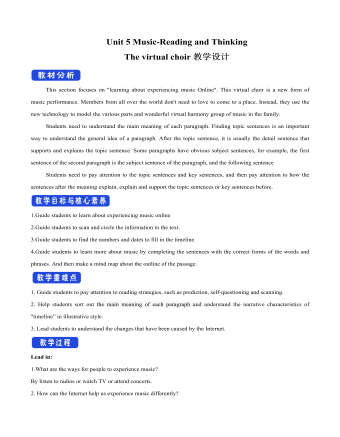
新人教版高中英语必修2Unit 5 Music-Reading and Thinking教案一
This section focuses on "learning about experiencing music Online". This virtual choir is a new form of music performance. Members from all over the world don't need to love to come to a place. Instead, they use the new technology to model the various parts and wonderful virtual harmony group of music in the family. Students need to understand the main meaning of each paragraph. Finding topic sentences is an important way to understand the general idea of a paragraph. After the topic sentence, it is usually the detail sentence that supports and explains the topic sentence. Some paragraphs have obvious subject sentences, for example, the first sentence of the second paragraph is the subject sentence of the paragraph, and the following sentenceStudents need to pay attention to the topic sentences and key sentences, and then pay attention to how the sentences after the meaning explain, explain and support the topic sentences or key sentences before.1.Guide students to learn about experiencing music online2.Guide students to scan and circle the information in the text.3.Guide students to find the numbers and dates to fill in the timeline.4.Guide students to learn more about music by completing the sentences with the correct forms of the words and phrases. And then make a mind map about the outline of the passage.1. Guide students to pay attention to reading strategies, such as prediction, self-questioning and scanning.2. Help students sort out the main meaning of each paragraph and understand the narrative characteristics of "timeline” in illustrative style.3. Lead students to understand the changes that have been caused by the Internet.

新人教版高中英语必修2Unit 5 Music-Reading for Writing教案二
The Internet celebrity Gao Yifeng. Years ago, he owned 5 companies and the staffs over 1,000, but during the economy crisis, he became nothing but debt. He was so worried that his hair became white overnight. There was a time when he wanted to killed himself. But after listening to the song Start Over by Liu Huan, he decided to cheer himself up. He started a steamed bun shop and gradually became a national chain shops. Now he became successful again.Walter Haddon said, “Music is the medicine of a troubled mind.” Music contains such a pleasant and inspiring force. Music gave him courage and bravery. When he listened to the song, it made his spirit fly like a kite in the wind. Music gave him strength and brought him relief. It was the rock I leant on to become strong and to get through those hard times. I hope none of us have to go through the same kind of suffering that he did. At the same time, we all go through various periods when we feel sad or alone. During those times, music can help us in the same way that it helped him. I hope we all will somehow begin to treasure music and make it a part of our life. Thank you for your listening !5.Revise your writing each other.Does he/she explain how music has changed his/her/someone else’s life?Are some of the rhetorical devices included and used properly ?Does he/she talk about how music makes him/her/someone feel?Is the first word in each sentences capitalised?Does he/she use correct punctuation ?

新人教版高中英语必修2Unit 5 Music-Reading For Writing教案一
(4)Now we have heard a number of outstanding speeches ... 我们已经聆听了许多精彩的发言……(5)Because we wanted the nations of the world, working together, to deal with ... 因为我们希望全世界各国团结起来去应对……(6)And if we do not act ... 如果我们不采取行动……(7)Now, I share the concerns that have been expressed ... 我也同意对于……表达的担心(8)Let us show the world that by working together we can ... 让我们告诉全世界,通过一起努力我们可以……(9)It is now time for us to ... 是时候我们……(10)And I have always wished that ... 我一直希望……(11)Thank you for letting me share this day with me.感谢你们和我共度这一天。实践演练:假如你是高中生李华,你校将举办一次以“音乐”为主题的演讲比赛,请你按照主题,写下你的演讲稿。注意:词数100左右。First of all, thank you for listening to my speech. My topic is: love music like love yourself.Music is like the air we need to maintain our normal lives around us. You can't imagine how terrible a world without music would be. Movies and TV shows have no music, only dry conversations and scenes; mobile phones only vibrations; streets only noisy crowds; cafes, western restaurants only depressed meals. What a terrible world it is!As a student, I hope we all can enjoy the fun brought by music in our spare time. Instead of just listening to music, we can even make our own music. Let's enjoy the fun of music!Thanks again for your attention!
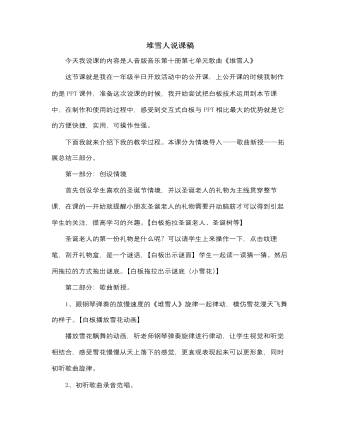
人音版小学音乐五年级上册堆雪人说课稿
第二首是中国歌曲《龙咚锵》,欣赏后师生共同讨论下我国过年的习俗,然后在《堆雪人》伴奏的背景音乐下,观看中国过年时的各种场景【白板播放歌曲拖拉图片】这部分环节的设计是让学生初步感受不同地域的音乐风格和音乐所表达的“过新年”热闹氛围,了解过年的风俗,在音乐学习中受到节日文化的熏陶,感受音乐与生活、与自然的关系。最后播放《堆雪人》视频,【白板播放歌曲视频】学生在《堆雪人》的音乐声中,在亲身制作的贺年卡上,贴上雪花窗花贴纸,作为新年的礼物送给父母。感恩父母感受生活的幸福,同时《堆雪人》这首歌曲的旋律也贯穿了整节音乐课。本次是我把电子白板运用到音乐教学中的初次尝试,在制作与操作的过程中明显还不够熟练,有待提高。请在座的各位领导老师们多提宝贵意见,谢谢大家。

人音版小学音乐二年级上册小拜年说课稿
打击乐器是小学生喜欢的乐器。让学生在音乐课上演奏打击乐器,不但可以提高学生的学习兴趣,同时也能培养对音乐的感知力。让学生为乐曲加上打击乐器伴奏。在鼓、钹声中,学生的参与意识被激发。加强了学生对音乐的理解,增强了音乐的表现力。(五)拓展延伸 。 1、让音乐与生活沟通起来音乐本来就是从生活中创造出来的。我们在音乐教学过程中根据教学需要,实现教师、学生、教材、教具、教学环境与生活的多方面横向联系,及他们之间的相互作用和影响。 (六)、课堂小结。课堂小结:是在完成某项教学任务的终了阶段,教师富有艺术性的对所学知识和技能进行归纳、总结和升华的行为方式,它常用于课堂的结尾,所以形象地被称作"豹尾"。完善、精要的"小结",可以使课堂教学锦上添花,余味无穷,让学生达到前后浑然一体的美妙境界,以激发学生学习音乐课的热情,同时性情也受到熏陶。
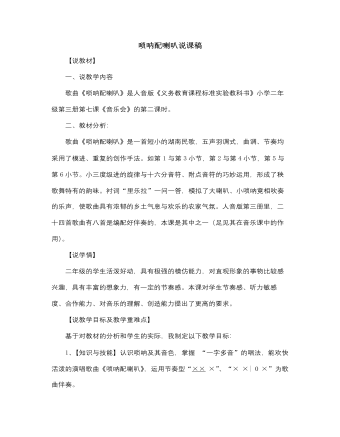
人音版小学音乐二年级上册唢呐配喇叭说课稿
我会在此基础上指导唱喇.(啊) 叭,唢.(哦) 呐,并告诉他们“这两个附点运用得特别巧妙,既好像是唢呐和喇叭发出的颤音,又像是表现演奏者的得意、潇洒和自在的样子”让学生感受其唱法。然后我点个别学生唱。接着让学生接龙唱,我说“喇叭的声音低沉,就像男生的声音,唢呐的声音高亢,就像女生的声音,那男生唱喇叭,女生唱唢呐”,利用男女生声音的特点表现模仿歌曲中唢呐和喇叭的声音。(3)重点句处理完后,学生应该知道该如何表现歌曲了,然后再利用师生对唱、生生对唱、齐唱等方式巩固歌曲,加深学生对歌曲的熟悉程度。(4)然后再引入果冻宝宝“果冻宝宝们对你们的表现很满意,他们也想加入进来,瞧,他们排好队了,你们还记得怎么拍吗?”分别边唱边用0 0 |×× ×,× ×| 0 ×拍手伴奏。4、为歌曲配打击乐器伴奏,增添民间的热闹气氛我拿出打击乐器大镲和军鼓,请学生选择黑板上的节奏型,或者自己创编节奏为歌曲伴奏,其他学生边唱边吹。
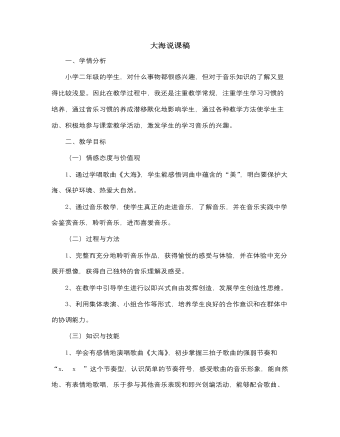
人音版小学音乐二年级上册大海说课稿
教师弹琴,提示学生融入情感演唱歌曲后半部分。(7)出示全部歌谱,教师弹琴,学生跟琴声完整演唱全曲。(教师提示:注意歌唱情绪及节奏,听好音乐,注意歌唱姿势)(8)教师播放歌曲范唱,学生合音乐完整演唱歌曲。教师提示学生,可以用自己的肢体动作随着音乐即兴创编能表现出大海的律动动作进行表演。9.分小组表演歌曲《大海》,教师做几个简单动作,鼓励学生大胆创编动作为歌曲表演。10.分组表演:一组演唱歌曲,一组用身体的律动来表现。(三)课堂拓展(课堂小结)教师请同学们谈谈这节课的“收获”, 引导学生说出学习的内容,想到的事物。然后出示“海洋污染“的几幅图片,让同学们说说自己的看法和想法。最后教师总结:要好好保护环境,不要乱丢垃圾,热爱我们的海洋,热爱我们的地球,一起努力争当一名保护地球文明的小金星。
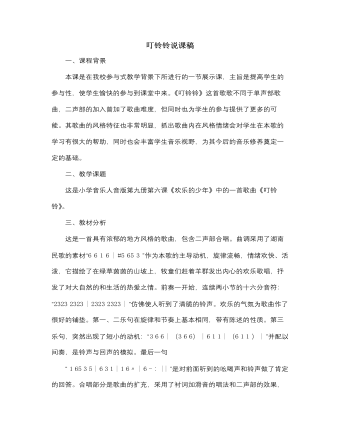
人音版小学音乐五年级上册叮铃铃说课稿
师:同学们唱的可真棒,你瞧,安妮安娜这对双胞胎还邀请我们为他们伴唱呢!5.学习第一声部师:那让我们也来当回牧童呼唤可爱的小羊吧!师:为了让羊群能听到我们的呼唤声,让我们把声音传的更远些!6.二声部练习(1)第一次合唱师:同学们学的可真快,现在我们高低声部一起来唱唱,看看谁最能站稳自己的声部。(2)学生自我评价,教师提议师:你们觉得我们刚才唱的怎么样?那我们该怎么唱才会更好听呢?(3)第二次合作(5)最后一句师:高声部表现的牧童可自豪了,来拿起你们的羊鞭,低声部表现的牧童可是非常温柔的,7.第三次完整演唱歌曲师:在绿茵茵的高山坡上,吆喝声,叮铃声,这么多的声音交织在一起多热闹啊,让我们愉快的唱一唱第一段吧8.听录音体验歌曲的风格师:请同学们边唱边想一想,如果你是牧童的话,你最喜欢在哪里挥鞭赶羊群?请跟着音乐挥一挥羊鞭
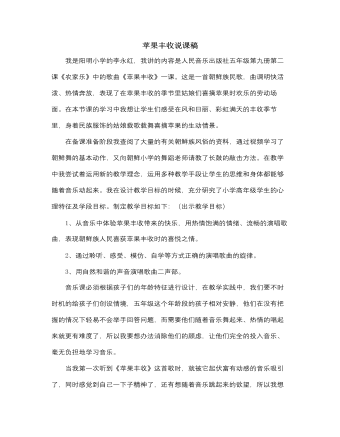
人音版小学音乐五年级上册苹果丰收说课稿
通过这种方法,一步一步,由浅入深的让学生感受、体验、表现,在增加喜庆气氛的同时感受朝鲜舞的特点,进而使学生对朝鲜族的音乐风格有了一定的了解。《苹果丰收》歌曲速度很快,能够轻松地咬字、吐字,清晰的表达歌曲内容是本课的另一个重点。因此,我重新录制了音乐,学习的过程中我随时根据学生的学习情况改变音乐的速度,在歌曲学会后再逐渐加快速度,这样使学生学起来轻松了许多。然后,我又以歌中的一句为例,让学生看着又红又大的苹果做吃苹果时的样子和甜滋滋的表情,让学生就带着这样的感受来唱“一个个苹果惹人爱,惹呀么惹人爱”一句,我在此处进行声音和情感的处理,达到满意后再延伸到整首歌曲,最后达到从音乐中体验苹果丰收带来的快乐,用热情饱满的情绪、流畅的演唱歌曲,表现朝鲜族人民喜获苹果丰收时的喜悦之情的教学目标。本课教学设计之不足之处,将在进一步的教学实践中改进。
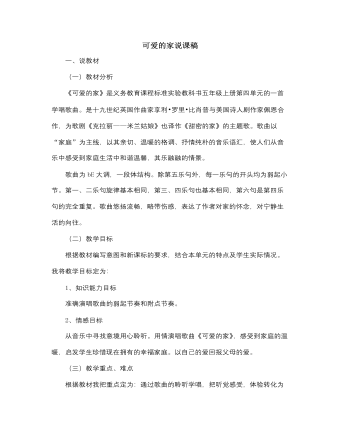
人音版小学音乐五年级上册可爱的家说课稿
4、带唱利用电子琴伴奏,教师带唱的方式,引导学生唱好弱起节奏和附点节奏。第三个环节延伸[设计理念:新课改提倡学科综合。依据这一理念,我在这一环节中让学生动手画一画,体现了音乐与美术的联系,让学生从画中体会家的温馨。再用歌声表达自己对家的感情。1、画一画让学生动手画一画自己的家。提示学生家是怎么样的?有哪些人?2、说一说先让学生说一说自己画的“家”(可以是想象的家),再说说自己“可爱的家”(真实的家),启发学生感受到父母对孩子的爱是无私的爱,启发学生珍惜现在拥有的幸福家庭,以自己的爱去回报父母的爱。3、唱一唱让学生把听觉感受、体验转化为自我表现。我让个别学生来演唱,强调学生用“自然”、“自主”、“自信”有表情的来演唱。
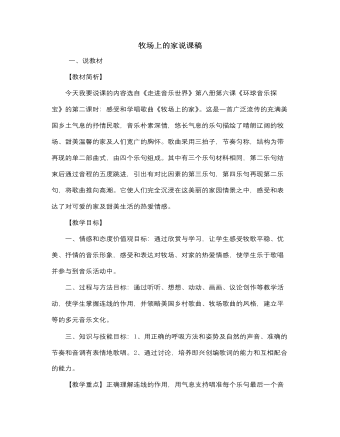
人音版小学音乐五年级上册牧场上的家说课稿
朴素深情悠长气息松散的节奏晴朗辽阔甜美温馨宽广的胸怀5、当学生唱两三次后,歌词就唱得较熟了,这时可以启发学生处理好歌曲中A乐句与B乐句的演唱力度,唱出mf与mp的力度对比。还可以启发他们用不同的演唱形式来表现音乐。6、教师范唱,最后全班用高位置的混声和圆润的音色来深情地演唱歌曲《牧场上的家》,尽情地表达对家乡的热爱。7、展示评价三、第三环节:拓展创编歌词(10分钟)听中编。同学们自编歌词,尽情歌唱自己的家。如:“猎德的家”、“我的家”、等。引导学生可根据我校综合实践课程的特色来创编歌词,歌唱猎德村改造前后的变化或心理感受。这时采用示范的方式展示和演唱老师创作的歌词,再让小组讨论并展示,还可让他们加上自制的打击乐器伴奏。最后是中肯的评价。
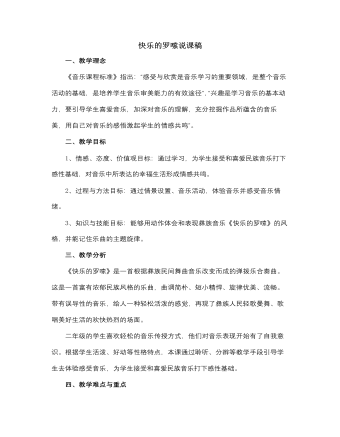
人音版小学音乐二年级上册快乐的罗嗦说课稿
一、教学理念《音乐课程标准》指出:“感受与欣赏是音乐学习的重要领域,是整个音乐活动的基础,是培养学生音乐审美能力的有效途径”,“兴趣是学习音乐的基本动力,要引导学生喜爱音乐,加深对音乐的理解,充分挖掘作品所蕴含的音乐美,用自己对音乐的感悟激起学生的情感共鸣”。二、教学目标1、情感、态度、价值观目标:通过学习,为学生接受和喜爱民族音乐打下感性基础,对音乐中所表达的幸福生活形成情感共鸣。2、过程与方法目标:通过情景设置、音乐活动,体验音乐并感受音乐情绪。3、知识与技能目标:能够用动作体会和表现彝族音乐《快乐的罗嗦》的风格,并能记住乐曲的主题旋律。三、教学分析《快乐的罗嗦》是一首根据彝族民间舞曲音乐改变而成的弹拨乐合奏曲。这是一首富有浓郁民族风格的乐曲,曲调简朴、短小精悍、旋律优美、流畅。

人音版小学音乐二年级上册森林水车说课稿
第四环节:森林印象1.完整聆听,找出表现小水花的主题音乐,了解回旋曲式请孩子们听到小水花的主题音乐时,轻轻地唱并用律动表现欢快的小水花——在这我给大家准备了音乐片段由水车上飞溅下来的小水花穿过了小木屋,流进了田野就这样快乐地回旋在森林中……2.介绍作曲家:这么美的音乐是德国喜歌剧作曲家艾伦贝格留给我们的,你想对他说些什么?3.在森林水车的音乐声中朗诵儿童诗来结束本课(希望孩子们就是那快乐的水花)绿色的水车转呀,快乐的小水花呀:飞着、跳着、唱着、笑着一路奔跑,一路播撒,回旋在小溪、田野、山花中一路欢呼,一路舞蹈,是你,是我,是他我们就是一群快乐的小水花!我的说课内容到这就结束了,希望今天我带来的小水花也能回旋在你们的心中